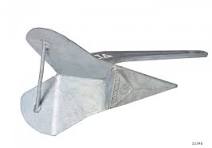Anchoring in Soft Caribbean Sand: Top Anchor Choices for Secure and Stress-Free Mooring in Sandy Seabeds
When cruising the Caribbean, particularly in areas with soft sandy bottoms like we encounter in both the USVI and BVI waters, the choice of anchor is crucial for safety, convenience, and peace of mind. Anchoring in the warm, turquoise waters of the Caribbean is one of the most rewarding aspects of boating in this region. However, the variety of seabed compositions requires a thoughtful selection of anchoring equipment to ensure your vessel stays secure, especially in soft sand. Below, we explore the best anchors for this purpose and the considerations that make them ideal for these conditions.
Characteristics of Soft Caribbean Sand
Soft sand is prevalent in the Caribbean, offering excellent holding potential for anchors designed to penetrate and grip effectively. However, the challenge lies in selecting an anchor capable of achieving deep penetration without excessive dragging, even in shifting tides or moderate swells. Soft sand anchors must balance ease of setting, holding power, and resistance to shifting under load.
Top Anchors for Soft Sand
1. Rocna Anchor
The Rocna anchor is widely regarded as one of the best all-around anchors, and it performs exceptionally well in soft sand. Its roll bar and sharp, chisel-tip fluke allow it to set quickly and deeply. The design ensures that the anchor always lands in the correct orientation, optimizing its ability to dig into the seabed.
Advantages:
- Superior holding power due to deep penetration.
- Versatile performance in various seabed types.
- Self-righting design for consistent reliability.
Considerations:
- The roll bar can make stowing challenging on some bow rollers.
- Heavier than some other designs.
2. Mantus Anchor
The Mantus anchor is another top performer in soft sand. Its sharp tip and concave fluke design allow it to achieve a firm hold even in loose or shifting sands. The Mantus also disassembles for easy storage, making it popular among cruisers with limited space.
Advantages:
- Excellent setting ability in soft sand.
- High holding power.
- Easy to disassemble and store.
Considerations:
- Slightly bulkier than other designs when assembled.
- The sharp edges require careful handling to avoid injury.
3. Delta Anchor
The Delta anchor is a popular choice for many boaters due to its reliability and simplicity. Its plow-shaped design performs well in soft sand, providing good penetration and a strong hold.

The Delta anchor is a solid choice when boating in the USVI and BVI waters
Advantages:
- Durable, single-piece construction.
- Versatile and effective in soft sand.
- Affordable compared to premium anchors.
Considerations:
- May require more scope to set effectively in very soft sand.
- Slightly less holding power compared to Rocna or Mantus anchors.
4. Fortress Anchor
The Fortress anchor is lightweight, corrosion-resistant, and highly effective in soft sand. Made from high-strength aluminum, it’s easy to handle and adjust. The Fortress features adjustable fluke angles (32° or 45°), making it particularly effective in soft sand.

My personal favorite, the Fortress anchor
Advantages:
- Adjustable fluke angles for optimal penetration.
- Lightweight and easy to deploy.
- Corrosion-resistant aluminum construction.
Considerations:
- Lightweight design can struggle in harder seabeds.
- Requires careful storage to avoid damage to its sharp edges.
5. Spade Anchor
The Spade anchor is another excellent option for soft sand. Its concave fluke and weighted tip provide exceptional holding power and reliability. The Spade’s innovative design ensures quick setting and excellent resistance to dragging.
Advantages:
- Excellent holding power in soft sand.
- Robust and durable construction.
- Performs well in a variety of seabeds.
Considerations:
- More expensive than some alternatives.
- Bulkier to store due to its design.
Key Factors in Choosing an Anchor
- Size and Weight: Ensure the anchor matches your vessel’s size and weight. A larger or heavier boat requires a correspondingly larger anchor to maintain adequate holding power.
- Anchor Rode: Use a combination of chain and rope for the anchor rode. A heavy chain helps to keep the pull angle low, improving holding power in soft sand.
- Scope: Use a scope ratio of at least 5:1 (length of rode to water depth) in calm conditions. For more challenging conditions, increase the ratio to 7:1 or more.
- Setting Technique: Properly setting the anchor involves backing down gently with your engine to ensure the anchor is buried deeply. Check for drag by observing fixed landmarks or using your GPS.
- Redundancy: Consider carrying a secondary anchor as a backup or for tandem anchoring in severe weather.
Maintenance and Storage
Proper maintenance of your anchor and rode ensures longevity and reliability:
- Rinse your anchor with fresh water after use to remove salt and sand.
- Inspect the anchor, chain, and rope regularly for signs of wear or corrosion.
- Store the anchor securely to prevent damage to your vessel or injury to crew members.
Additional Tips for Anchoring in Soft Sand
- Scout the Anchorage: Use a depth sounder and visual inspection to identify areas of soft sand and avoid rocky or grassy patches.
- Consider Swing Radius: Allow for adequate space around your vessel in case of shifting winds or currents.
- Monitor Conditions: Keep an eye on weather forecasts and tidal changes, which can affect anchoring conditions.
- Anchor Alarms: Use an anchor alarm on your GPS or chartplotter to alert you if your boat drifts beyond a set radius.
In conclusion, anchoring in soft Caribbean sand can be a stress-free experience when equipped with the right anchor and techniques. The Rocna, Mantus, Delta, Fortress, and Spade anchors each offer unique advantages, making them excellent choices for anchoring in the U.S and British Virgin Island waters that we boat in daily. By considering factors such as anchor size, weight, and setting technique, you can ensure a secure hold and enjoy the stunning beauty of the Caribbean’s sandy bays and coves. With proper care and preparation, your anchor will provide the reliability and confidence you need for countless memorable voyages.
